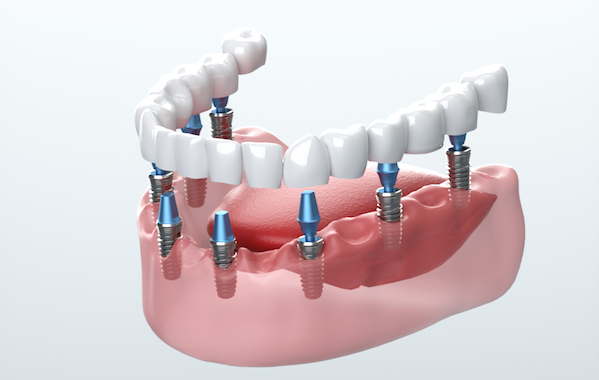Dental Implants Fundamentals Explained
Dental Implants Fundamentals Explained
Blog Article
How Dental Implants can Save You Time, Stress, and Money.
Table of ContentsGet This Report about Dental ImplantsThe Best Strategy To Use For Dental ImplantsThe Best Strategy To Use For Dental ImplantsHow Dental Implants can Save You Time, Stress, and Money.
are medical tools surgically implanted into the jaw to restore a person's capacity to eat or their appearance. They give assistance for synthetic (phony) teeth, such as crowns, bridges, or dentures. When a tooth is lost due to injury or disease, a person can experience issues such as fast bone loss, defective speech, or modifications to eating patterns that lead to pain.
Structure of The Oral Implant System choosing dental implants, speak to your dental company concerning the potential benefits and threats, and whether you are a prospect for the procedure. Points to take into consideration: Your general health is a crucial aspect in establishing whether you are a great prospect for oral implants, just how long it will take to recover, and for how long the implant might remain in area.
Smoking might affect the recovery process and lower the long-lasting success of the implant. The healing process for the dental implant body may take a number of months or longer, during which time you normally have a momentary joint instead of the tooth. the dental implant procedure: Carefully comply with the dental hygiene guidelines offered to you by your oral company.
The Of Dental Implants
Implant failing can result in the need for another procedure to take care of or replace the implant system. Recovers the capacity to eat Recovers cosmetic appearance Aids keep the jawbone from diminishing because of bone loss Preserves the health of the surrounding bone and gum tissues Aids keep nearby (nearby) teeth secure Enhances quality of life Damage to bordering all-natural teeth throughout implant positioning Injury to the surrounding cells during surgical treatment, such as sinus opening Injury throughout surgical procedure (for example, crack of bordering jawbone) Poor feature, such as seeming like the teeth do not attack with each other usually A sensation that the tooth is loose or twisting in position arising from a joint screw loosening Implant body failure (looseness of the dental implant body) due to systemic infection, which may be most likely in people with unchecked diabetes mellitus because of neighborhood infection in bone and gum tissues sustaining the implant body due to postponed recovery, which may be more probable in individuals who smoke Problem cleansing the periodontals around the dental my website implant, resulting in bad dental health Neglected periodontal illness Post-surgical tingling because of nerve impingement or damages Constantly alert wellness treatment providers and imaging service technicians that you have dental implants prior to any kind of magnetic vibration imaging (MRI) or x-ray procedures.
FDA is not familiar with any kind of negative occasions reported for MRI or x-ray treatments with oral implants. Oral implants systems are generally constructed from materials that adhere to international agreement requirements of the International Company for Standardization (ISO) or ASTM International. These criteria have information of what makes a safe product.
Dental implant systems are examined according to worldwide consensus standards. Biocompatibility testing, link to reveal that bodily contact with the device does not trigger problems like irritation or allergic reaction, is component of the evaluation that assists ensure the products in the dental implant system are secure and do not create damaging effects when implanted in people.

The Dental Implants Statements
Some people are not eligible for oral implant surgery. It is for oral specialists to operate individuals with: acute illnessuncontrollable metabolic diseasebone or soft cells condition or infectionIf these issues are settled, a person can have the surgical treatment. Dental Implants. In, dental doctors avoid operating people with: If individuals with any of the above undertake oral implant surgery, there is a greater danger of the implant stopping working
Some individuals have go right here a jawbone problem that prevents sufficient bone for a dental implant from establishing. In such cases, a surgeon might require to do a ridge modification. This entails lifting the gum to subject the area of flawed bone. The surgeon will then utilize a bone or bone alternative to fix and build up the location.
Oral dental implant surgery is a personalized process. It's not the exact same for everyone. The adhering to provides a general review of what you can expect your dental professional, dental specialist, periodontist or prosthodontist to do: Position the dental implant surgically. Provide you time to recover. Affix the message and final crown, bridge or denture.
Next off, your surgeon will thoroughly position the oral implant right into your jaw. Your cosmetic surgeon will certainly rearrange your gum tissues and close the cut with stitches (Dental Implants). If your implant is near the front of your mouth, your dentist will certainly make a short-lived tooth for you to put on until you heal. This way, you won't have a void in your smile while you recover.
Excitement About Dental Implants
Your service provider can inform you what to anticipate in your circumstance. During the recovery stage, your jawbone needs to fuse to the dental implant. This procedure, called osseointegration, is critical for stability and lasting success. This process can take anywhere from three to nine months. In some instances, it might take longer.
When your implant heals, your dental expert can attach the abutment (small connector blog post) and your last reconstruction (crown, bridge or denture). This normally takes regarding one hour to finish and may call for a 2nd small surgical treatment. You shouldn't feel any kind of pain throughout your oral implant treatment due to the fact that your service provider will make use of medication to numb your gum tissues.
Report this page